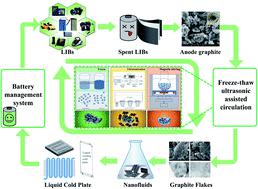当前位置:
X-MOL 学术
›
Sustain. Energy Fuels
›
论文详情
Our official English website, www.x-mol.net, welcomes your
feedback! (Note: you will need to create a separate account there.)
A facile freeze–thaw ultrasonic assisted circulation method of graphite flakes prepared by anode graphite from spent lithium-ion batteries for application in nanofluids
Sustainable Energy & Fuels ( IF 5.0 ) Pub Date : 2021-08-16 , DOI: 10.1039/d1se00973g Yu Qiao 1 , Wen Sheng 1 , Chen He 1 , Bai Yang 1 , Haoxuan Xu 1 , Chenzhen Liu 1 , Zhonghao Rao 1
Sustainable Energy & Fuels ( IF 5.0 ) Pub Date : 2021-08-16 , DOI: 10.1039/d1se00973g Yu Qiao 1 , Wen Sheng 1 , Chen He 1 , Bai Yang 1 , Haoxuan Xu 1 , Chenzhen Liu 1 , Zhonghao Rao 1
Affiliation

|
Graphite has been widely used as the anode material in lithium-ion batteries (LIBs) due to its good conductivity, layered crystal structure, high charging–discharge potential, and other characteristics. With the rapid development of the LIB industry, the graphite industry has also developed into a mode of high production capacity. The anode graphite of spent LIBs has the characteristics of large layer spacing and ease of being intercalated and peeled due to the reduction of the interlamination force after repeated charge and discharge cycles. In this study, we present a facile freeze–thaw ultrasonic assisted circulation method to prepare two-dimensional low-layer graphite flakes (GFs) using anode graphite from spent LIBs. Characterizations of GFs were carried out by SEM, TEM, XRD and Raman spectroscopy. The results indicate that GFs prepared by graphite of spent LIBs have a better morphology than that prepared by purchased graphite. Furthermore, the GF-filled ethylene glycol (EG) nanofluids exhibit higher thermal conductivity and conductive heat transfer coefficient than base fluids, of which the maximum enhancements are 10.5% and 30%, respectively. The freeze–thaw ultrasonic assisted circulation method is not only an effective method for the reuse of anode graphite from spent LIBs, but also a reference for the synthesis of two-dimensional materials. Furthermore, GF-filled nanofluids could be a potential heat transfer working medium.
中文翻译:

废锂离子电池负极石墨制备石墨薄片的简便冻融超声辅助循环方法在纳米流体中的应用
石墨由于具有良好的导电性、层状晶体结构、高充放电电位等特性,已被广泛用作锂离子电池(LIBs)的负极材料。随着LIB产业的快速发展,石墨产业也发展成为高产能模式。废LIBs的负极石墨具有层间距大、由于反复充放电循环后层间力降低而易于插层和剥离的特点。在这项研究中,我们提出了一种简便的冻融超声辅助循环方法,使用来自废锂离子电池的阳极石墨制备二维低层石墨薄片(GFs)。通过 SEM、TEM、XRD 和拉曼光谱对 GF 进行表征。结果表明,用废LIBs石墨制备的GFs比外购石墨制备的GFs具有更好的形貌。此外,填充GF的乙二醇(EG)纳米流体比基础流体表现出更高的热导率和导热系数,其中最大的增强分别为10.5%和30%。冻融超声辅助循环法不仅是废锂电池负极石墨再利用的有效方法,也是二维材料合成的参考。此外,填充玻璃纤维的纳米流体可能是一种潜在的传热工作介质。GF 填充的乙二醇 (EG) 纳米流体比基础流体表现出更高的热导率和传导传热系数,其中最大的增强分别为 10.5% 和 30%。冻融超声辅助循环法不仅是废锂电池负极石墨再利用的有效方法,也是二维材料合成的参考。此外,填充玻璃纤维的纳米流体可能是一种潜在的传热工作介质。GF 填充的乙二醇 (EG) 纳米流体比基础流体表现出更高的热导率和传导传热系数,其中最大的增强分别为 10.5% 和 30%。冻融超声辅助循环法不仅是废锂电池负极石墨再利用的有效方法,也是二维材料合成的参考。此外,填充玻璃纤维的纳米流体可能是一种潜在的传热工作介质。
更新日期:2021-09-02
中文翻译:

废锂离子电池负极石墨制备石墨薄片的简便冻融超声辅助循环方法在纳米流体中的应用
石墨由于具有良好的导电性、层状晶体结构、高充放电电位等特性,已被广泛用作锂离子电池(LIBs)的负极材料。随着LIB产业的快速发展,石墨产业也发展成为高产能模式。废LIBs的负极石墨具有层间距大、由于反复充放电循环后层间力降低而易于插层和剥离的特点。在这项研究中,我们提出了一种简便的冻融超声辅助循环方法,使用来自废锂离子电池的阳极石墨制备二维低层石墨薄片(GFs)。通过 SEM、TEM、XRD 和拉曼光谱对 GF 进行表征。结果表明,用废LIBs石墨制备的GFs比外购石墨制备的GFs具有更好的形貌。此外,填充GF的乙二醇(EG)纳米流体比基础流体表现出更高的热导率和导热系数,其中最大的增强分别为10.5%和30%。冻融超声辅助循环法不仅是废锂电池负极石墨再利用的有效方法,也是二维材料合成的参考。此外,填充玻璃纤维的纳米流体可能是一种潜在的传热工作介质。GF 填充的乙二醇 (EG) 纳米流体比基础流体表现出更高的热导率和传导传热系数,其中最大的增强分别为 10.5% 和 30%。冻融超声辅助循环法不仅是废锂电池负极石墨再利用的有效方法,也是二维材料合成的参考。此外,填充玻璃纤维的纳米流体可能是一种潜在的传热工作介质。GF 填充的乙二醇 (EG) 纳米流体比基础流体表现出更高的热导率和传导传热系数,其中最大的增强分别为 10.5% 和 30%。冻融超声辅助循环法不仅是废锂电池负极石墨再利用的有效方法,也是二维材料合成的参考。此外,填充玻璃纤维的纳米流体可能是一种潜在的传热工作介质。











































 京公网安备 11010802027423号
京公网安备 11010802027423号